
Insects in the family Tettigoniidae are commonly called katydids, or bush crickets. They have previously been known as "long-horned grasshoppers". More than 8,000 species are known. Part of the suborder Ensifera, the Tettigoniidae are the only extant (living) family in the superfamily Tettigonioidea.
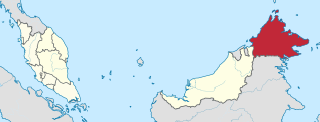
Sabah is a state of Malaysia located on the northern portion of Borneo, in the region of East Malaysia. Sabah has land borders with the Malaysian state of Sarawak to the southwest and Indonesia's North Kalimantan province to the south. The Federal Territory of Labuan is an island just off Sabah's west coast. Sabah shares maritime borders with Vietnam to the west and the Philippines to the north and east. Kota Kinabalu is the state capital and the economic centre of the state, and the seat of the Sabah State government. Other major towns in Sabah include Sandakan and Tawau. The 2020 census recorded a population of 3,418,785 in the state. It has an equatorial climate with tropical rainforests, abundant with animal and plant species. The state has long mountain ranges on the west side which forms part of the Crocker Range National Park. Kinabatangan River, the second longest river in Malaysia runs through Sabah. The highest point of Sabah, Mount Kinabalu is also the highest point of Malaysia. While internationally recognised as Malaysian territory, the Philippines maintains a dormant claim on the eastern portion of Sabah, on the basis that it was historically territory of the Sultanate of Sulu.

Orthoptera is an order of insects that comprises the grasshoppers, locusts, and crickets, including closely related insects, such as the bush crickets or katydids and wētā. The order is subdivided into two suborders: Caelifera – grasshoppers, locusts, and close relatives; and Ensifera – crickets and close relatives.
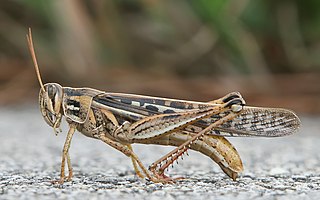
Grasshoppers are a group of insects belonging to the suborder Caelifera. They are among what is possibly the most ancient living group of chewing herbivorous insects, dating back to the early Triassic around 250 million years ago.

Ensifera is a suborder of insects that includes the various types of crickets and their allies including: true crickets, camel crickets, bush crickets or katydids, grigs, weta and Cooloola monsters. This and the suborder Caelifera make up the order Orthoptera. Ensifera is believed to be a more ancient group than Caelifera, with its origins in the Carboniferous period, the split having occurred at the end of the Permian period. Unlike the Caelifera, the Ensifera contain numerous members that are partially carnivorous, feeding on other insects, as well as plants.

The Phaneropterinae, the sickle-bearing bush crickets or leaf katydids, are a subfamily of insects within the family Tettigoniidae. Nearly 2,060 species in 85 genera throughout the world are known. They are also known as false katydids or round-headed katydids.
The International Institute for Species Exploration (IISE) is a research institute located in Syracuse, New York. Its mission is to improve taxonomical exploration and the cataloging of new species of flora and fauna. Since 2008, IISE has published a yearly "Top 10" of the most unusual or unique biota newly identified in the previous year, with the aim of drawing attention to the work done in taxonomy across the world over the previous year.
Panoploscelis is a genus of very large insects belonging to the true katydid tribe Eucocconotini, which is a subfamily of the Tettigoniidae. Like the other members of the suborder Ensifera, Panoploscelis are part of the insect order Orthoptera, which also contains crickets, grasshoppers and locusts. Members of this genus are among the largest katydids of the Neotropics.

Marleyimyia xylocopae is a species of bee fly from South Africa that has a similarity to the patterning of a carpenter bee Xylocopa flavicollis(De Geer, 1778) found in the region. The species is considered to be distinctive and only one of three within the genus Marleyimyia. The other members of the genus are Marleyimyia goliath described from Peninsular Malaysia and M. natalensis from southern Africa. Members in the genus have been presumed to be crepuscular or nocturnal but this species was found to be diurnal.

Copiphora rhinoceros, the rhinoceros katydid, is a relatively large, up to about 7.5 cm (3 in) long, species of katydid found in Central America. It belongs to a group known as the conehead katydids, several of which have a horn-like projection on the top of the head. The horn of the rhinoceros katydid is used to ward off attacks from hungry bats. Unlike most katydids, which are herbivores, the rhinoceros katydid is an omnivore, feeding on fruit, seeds, flowers, invertebrates, frog eggs and small lizards. The species can be quite noisy during the night and produces one of the dominant sounds in Central American lowland forests. Its lifespan is one to two years.
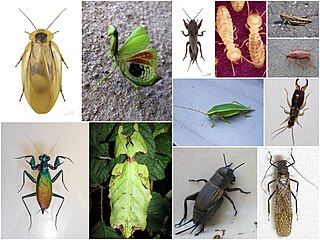
The cohort Polyneoptera is a proposed taxonomic ranking for the Orthoptera and all other Neopteran insects believed to be more closely related to Orthoptera than to any other insect orders. These winged insects, now in the Paraneoptera, were formerly grouped as the Hemimetabola or Exopterygota on the grounds that they have no metamorphosis, the wings gradually developing externally throughout the nymphal stages.
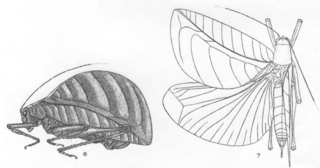
Eulophophyllum is a genus of leaf mimicking bush crickets or katydids in the subfamily Phaneropterinae. It was originally circumscribed in 1922 by Morgan Hebard as a monospecific genus for the species E. thaumasium, but two new species were described and added to the genus in 2016.
Arulenus miae is a species of pygmy grasshopper which is found on the island Mindanao in the Philippines. It was described in 2016 by Josip Skejo and Joy Honezza S. Caballero. They became aware of the species' existence through a photograph posted to a Facebook group. Specimens were later collected from Bukidnon Province. It is named in honor of a friend of Skejo, named Mia.
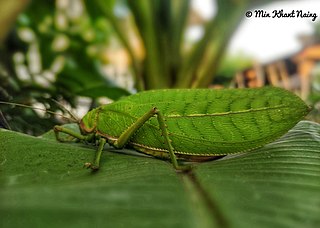
Pseudophyllus titan, the giant false leaf katydid, is a species of leaf-mimic bush-cricket of the subfamily Pseudophyllinae found in the canopy of tropical forests in Mainland Southeast Asia, Bangladesh, northeastern India, and southernmost China (Yunnan). It is among the largest species in the genus Pseudophyllus, which also makes it one of the world's largest Orthoptera, with a typical length of 13 cm (5.1 in) from head to tip of the folded wings and a wingspan of c. 23 cm (9.1 in). Like many other species of crickets and grasshoppers, the male is capable of stridulation, producing a relatively loud and distinctive, bird-like chirp; it usually stridulates ("sings") at night.

Capnobotes fuliginosus is a species of katydid known as the sooty longwing. It is found in the western United States and Mexico. It is omnivorous and it is the prey of the wasp Palmodes praestans.
Tomonotus is a genus of band-winged grasshoppers in the family Acrididae. There are at least two described species in Tomonotus.

Orophus tessellatus, the false leaf katydid, is a species of katydid native to Mexico, Central America, and South America. It is in the large subfamily Phaneropterinae within the tribe Amblycoryphini. Its coloring varies from brown to green, some with spots, mottling, or uniform in coloration. The body length reaches 16 mm (0.63 in) in males and 22 mm (0.87 in) in females. The ovipositor is approximate 7 mm (0.28 in) in length. The species is characterized by the size of the forewings and their "dirty" coloring.

Caedicia simplex is a species of bush cricket, native to New Zealand and Australia. Its common name is the common garden katydid.

Erechthis levyi, the blue-faced katydid or Eleuthera rhino katydid, is a katydid found in The Bahamas. Currently, it is described from specimens collected only on the island of Eleuthera. They are light brown in color throughout the body, but exhibit a bright turquoise-blue face and bear a prominent spine on the vertex of the head between the eyes, hence the common names. It is tentatively considered an endemic species to The Bahamas, as no specimens are recorded from Cuba or Hispaniola, where other Erechthis species occur. The species was named in honor of Leon Levy, a prominent Wall Street financier and philanthropist who spent much time on Eleuthera and was an avid admirer of the island's flora and natural beauty.
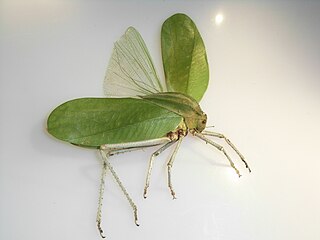
Siliquofera is a genus of bush cricket in the subfamily Phyllophorinae that includes only one species, Siliquofera grandis, which is fairly common and widespread in rainforest canopies of New Guinea and nearby smaller islands, and seemingly rare in Australia where only found in the remote Iron Range region. This very well-camouflaged, green and leaf-like bush cricket is one of the world's largest Orthoptera, with adults typically having a length of 10.7–13 cm (4.2–5.1 in) and a wingspan of 25–27 cm (9.8–10.6 in); it can weigh more than 30 g (1.1 oz).















